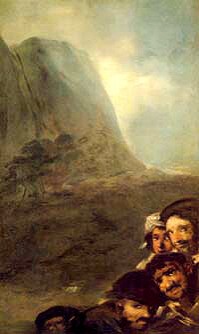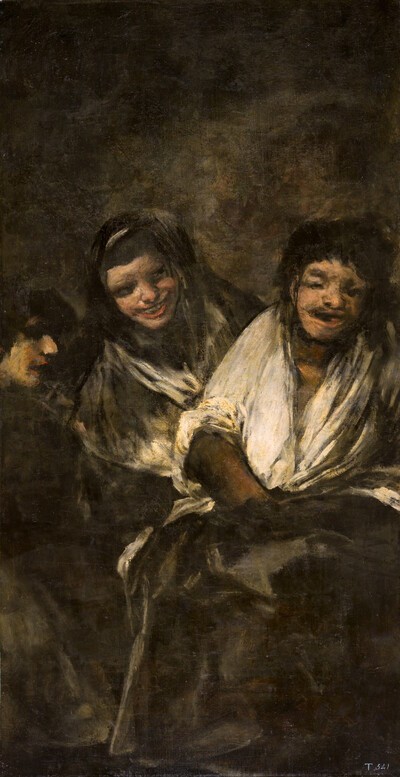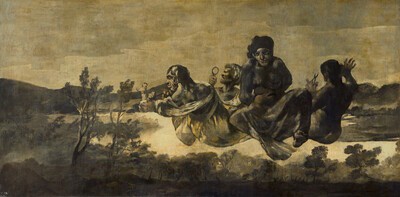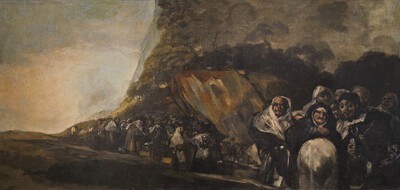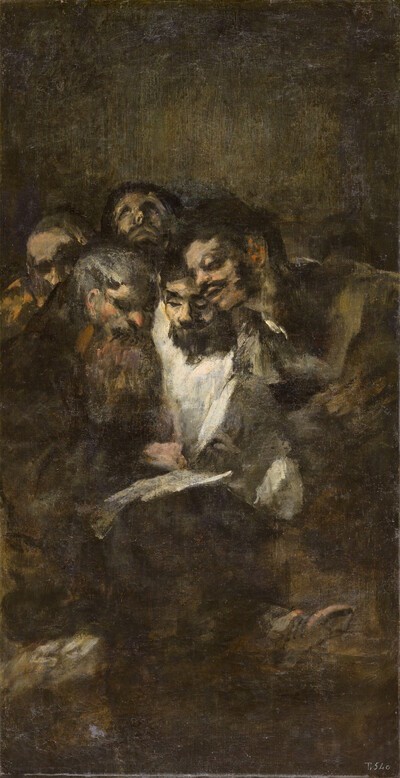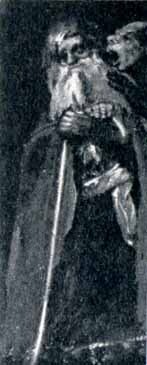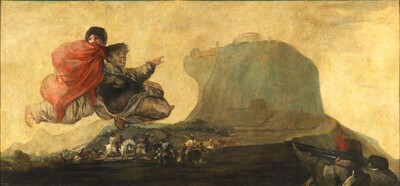- Cronología
- Ca. 1820 - 1823
- Ubicación
- The Prado National Museum. Madrid, Madrid, Spain
- Dimensiones
- 138.5 x 436 cm
- Técnica y soporte
- Oil painting on plaster transferred to canvas
- Reconocimiento de la autoría de Goya
- Documented work
- Titular
- El Prado National Museum
- Ficha: realización/revisión
- 28 Oct 2010 / 10 Jun 2024
- Inventario
- (P00760)
- Otros títulos:
-
Vision of the Pilgrimage to San Isidro (Visión de la romería de San Isidro)
See Leocadia.
This painting was located on the long wall of the right-hand side of the lower floor of the house known as the Quinta del Sordo, opposite Witches' Sabbath (El Aquelarre) or The Great He-Goat (El Gran Cabrón).
The scene is related to the pilgrimage that was celebrated in Madrid on the feast day of Saint Isidore, a theme which Goya had already dealt with in a tapestry cartoon entitled The Meadow of San Isidro (La pradera de San Isidro) (rec. no. ?). The cartoon showed a cheerful landscape full of bright colours. In contrast, here the viewer is confronted by a dark painting full of sinister pilgrims who do not seem to be celebrating at all; rather, they appear to have been driven into the country by desperation and fear.
The procession is led by a group in the foreground made up of a mass of bodies and heads whose expressions and gestures are macabre grimaces. At the head of the group is a singer who is playing the guitar and another character who carries a crook or cane. Behind them on the right-hand side of the composition the procession continues with a large group of sketched figures that are depicted with simple patches of paint. It is not possible to single out any individuals from this group, although the occasional veil can be made out among the gloomy crowd.
The setting for the procession has very little in common with the landscape depicted in the tapestry cartoon for The Meadow of San Isidro. This place is dominated by shadows and darkness. The light focus falls on the main group and is lost in the distance, creating a perspective. Despite the pervasive darkness, a castle and some walls can still be made out in the background.
Nordström links this painting and others on the ground floor with Saturn and the Saturnalia, a Roman festival in honour of the god, who - like Saint Isidore - is the patron of workers.
The artist used energetic and violent brushstrokes, applying much more paint to the group in the foreground than to the background. The colour palette is very dark, based on earthy, grey and black tones with the odd touch of red.
Apart from the restoration work carried out by Martínez Cubells in 1973, the Prado Museum also records further restoration work undertaken in 1954 by Pablo y Alarcón.
-
Pinturas Negras en la Exposición Universal de ParísPalacio del TrocaderoParís1878from may 20th to November 10th 1878
-
Goya. 250 AniversarioMuseo Nacional del PradoMadrid1996consultant editor Juan J. Luna. From March 29th to June 2nd 1996cat. 156
-
Goya, sa vie, son œuvreParísHenri Plon1867pp. 140
-
Goya, pintor de retratos, t. IMadridBlass y Cía1916pp.122-127
-
Goya, Saturno y melancolía. Consideraciones sobre el arte de GoyaStockholmAlquimis & Wiksell1962p.255-258
-
Goya. Las Pinturas NegrasMadridGoya Hispano-Inglesa de Reaseguros, D.L.1963pp. 115-120 y 125-126
-
Vie et ouvre de Francisco de GoyaParísOffice du livre1970p. 328, cat. 1626
-
BarcelonaPolígrafa1970vol. I, p. 378, cat. 703
-
GoyaBarcelonaCarroggio S.A. de Ediciones1974p. 201, cat. 584
-
Goya's Black Paintings: Truth and Reason in Light and LibertyNew YorkHispanic Society of America1984pp. 184-192
-
Las pinturas negrasMadridEdiciones Antiquaria, S.A1996pp. 104-105
-
Goya. Pinturas del Museo del PradoMadridMuseo Nacional del Prado1997pp. 309
-
Las Pinturas Negras de GoyaLondonScala Publishers Ltd.2003pp. 60-61

